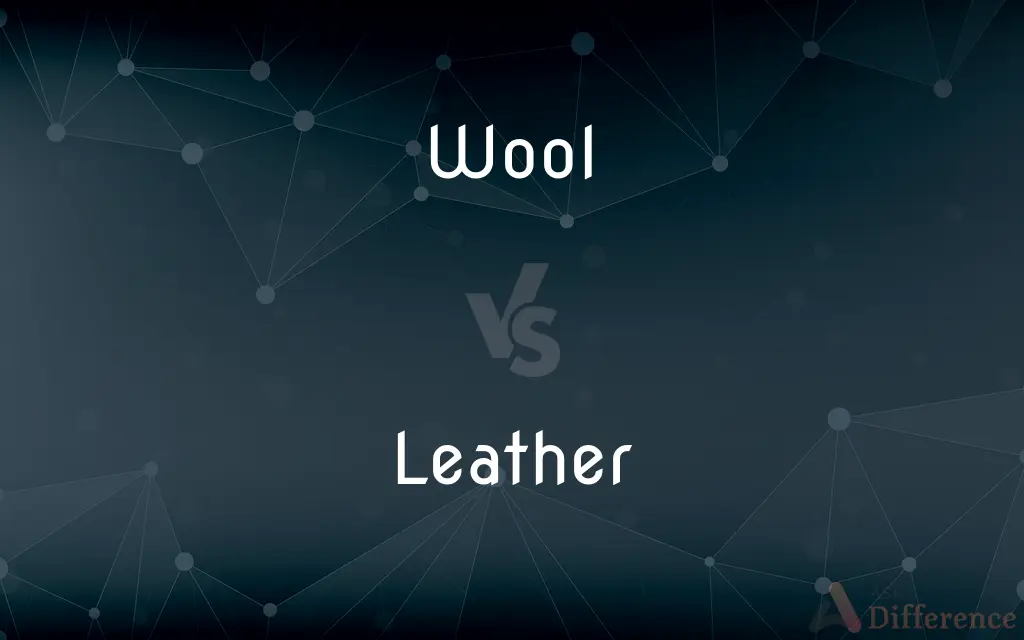Wool vs. Leather — What's the Difference?
Edited by Tayyaba Rehman — By Maham Liaqat — Updated on April 4, 2024
Wool, a soft, natural fiber from animals like sheep, is known for its warmth and breathability, while leather, made from animal hides, is durable and offers protection against elements.

Difference Between Wool and Leather
Table of Contents
ADVERTISEMENT
Key Differences
Wool is a natural fiber obtained from animals such as sheep, goats, and alpacas. It's celebrated for its warmth, breathability, and ability to regulate temperature, making it ideal for clothing that keeps one warm in winter and cool in summer. Leather, on the other hand, is made from the hides of animals like cows, pigs, and goats, treated through the process of tanning to produce a durable and resistant material. It's widely used in fashion, furniture, and accessories for its durability, protection, and aesthetic appeal.
While wool offers exceptional warmth and moisture-wicking properties, making it perfect for sweaters, socks, and winter wear, leather provides unmatched durability and protection, making it the material of choice for items that require resilience, such as jackets, shoes, and bags. Wool garments are often prized for their softness and comfort, whereas leather items are valued for their longevity and ability to shield against wind and rain.
The production process for wool involves shearing the animal's fleece, cleaning, and spinning it into yarn, which can then be woven or knitted into fabric. This process is generally more sustainable and less harmful to the environment than the production of leather, which requires chemical tanning processes that can have significant environmental impacts. However, advancements in tanning technologies have sought to reduce these effects, with options like vegetable tanning offering more eco-friendly alternatives.
Wool's ability to absorb moisture without feeling wet makes it a preferred material for active wear and garments worn in cold climates, as it can keep the wearer dry and comfortable. Leather, while not breathable in the same way wool is, excels in providing a barrier against external conditions, making it ideal for protective gear, high-quality footwear, and outerwear that faces harsh conditions.
The care and maintenance of wool and leather products also differ significantly. Wool items typically require gentle washing or dry cleaning to maintain their shape and quality, while leather demands regular conditioning to prevent drying out and cracking, and is more challenging to clean once stained. This difference in care requirements reflects the materials' unique properties and uses.
ADVERTISEMENT
Comparison Chart
Source
Sheep, goats, alpacas
Animal hides (cows, pigs, goats)
Key Properties
Warm, breathable, moisture-wicking
Durable, protective against elements
Uses
Sweaters, socks, winter wear
Jackets, shoes, bags
Sustainability
More sustainable, biodegradable
Environmental impact from tanning, though alternatives exist
Care and Maintenance
Gentle washing or dry cleaning
Conditioning, difficult to clean stains
Compare with Definitions
Wool
Moisture-Wicking.
Wool socks keep your feet dry and comfortable by wicking away moisture.
Leather
Aesthetic Appeal.
Leather furniture adds elegance and style to any room decor.
Wool
Temperature Regulation.
Wool blankets can be used year-round, thanks to their temperature-regulating properties.
Leather
Durability.
Leather boots are known for their long-lasting durability and protection.
Wool
Sustainability.
Wool is a renewable resource, with sheep producing new fleece each year.
Leather
Weather Resistance.
Leather jackets provide excellent protection against wind and rain.
Wool
Softness and Comfort.
High-quality wool garments are prized for their softness and comfort against the skin.
Leather
Versatility.
Leather can be used in a wide range of products, from fashion to upholstery.
Wool
Natural Insulation.
Wool sweaters are essential for cold weather, providing excellent insulation.
Leather
High Maintenance.
Leather goods require regular conditioning to maintain their appearance.
Wool
The fine, soft curly or wavy hair forming the coat of a sheep, goat, or similar animal, especially when shorn and prepared for use in making cloth or yarn
Harris tweed is made from pure new wool
Leather
Leather is a strong, flexible and durable material obtained from the tanning, or chemical treatment, of animal skins and hides to prevent decay. The most common leathers come from cattle, sheep, goats, equine animals, buffalo, pigs and hogs, and aquatic animals such as seals and alligators.Leather can be used to make a variety of items, including clothing, footwear, handbags, furniture, tools and sports equipment, and lasts for decades.
Wool
Wool is the textile fibre obtained from sheep and other animals, including cashmere and mohair from goats, qiviut from muskoxen, hide and fur clothing from bison, angora from rabbits, and other types of wool from camelids.Wool consists of protein together with a small percentage of lipids. In this regard it is chemically quite distinct from the more dominant textile, cotton, which is mainly cellulose.
Leather
A material made from the skin of an animal by tanning or a similar process
A leather jacket
Wool
The dense, soft, often curly hair forming the coat of sheep and certain other mammals, such as the goat and alpaca, consisting of cylindrical strands of keratin covered by minute overlapping scales and much valued as a textile fiber.
Leather
A piece of leather as a polishing cloth.
Wool
Fabric or yarn made of this hair.
Leather
Short for stirrup leather
Wool
Hairy or downy material on a plant or animal, as on certain caterpillars.
Leather
Beat or thrash (someone)
He caught me and leathered me black and blue
Wool
Filamentous or fibrous material similar to the wool of a sheep or other mammal.
Leather
The dressed or tanned hide of an animal.
Wool
The hair of the sheep, llama and some other ruminants.
Leather
Any of various articles or parts made of dressed or tanned hide, such as a boot or strap.
Wool
A cloth or yarn made from the wool of sheep.
Leather
The flap of a dog's ear.
Wool
Anything with a texture like that of wool.
Leather
To cover wholly or in part with the dressed or tanned hide of an animal.
Wool
A fine fiber obtained from the leaves of certain trees, such as firs and pines.
Leather
(Informal) To beat with a strap made of hide.
Wool
(obsolete) Short, thick hair, especially when crisped or curled.
Leather
Made of, relating to, or resembling dressed or tanned animal hide.
Wool
Yarn, including that made from synthetic fibers.
Leather
A tough material produced from the skin of animals, by tanning or similar process, used e.g. for clothing.
Wool
A resident of a satellite town outside Liverpool, such as St Helens or Warrington. See also Yonner.
Leather
A piece of the above used for polishing.
Wool
The soft and curled, or crisped, species of hair which grows on sheep and some other animals, and which in fineness sometimes approaches to fur; - chiefly applied to the fleecy coat of the sheep, which constitutes a most essential material of clothing in all cold and temperate climates.
Leather
(colloquial) A cricket ball or football.
Wool
Short, thick hair, especially when crisped or curled.
Wool of bat and tongue of dog.
Leather
(plural: leathers) clothing made from the skin of animals, often worn by motorcycle riders.
Wool
A sort of pubescence, or a clothing of dense, curling hairs on the surface of certain plants.
Leather
(baseball) A good defensive play
Wool
A fabric made from the hair of sheep
Leather
(boxing) A punch.
Wool
Fiber sheared from animals (such as sheep) and twisted into yarn for weaving
Leather
The skin.
Wool
Outer coat of especially sheep and yaks
Leather
Made of leather.
Leather
(transitive) To cover with leather.
Leather
(transitive) To strike forcefully.
Leather
(transitive) To spank or beat with a leather belt or strap.
Leather
The skin of an animal, or some part of such skin, with the hair removed, and tanned, tawed, or otherwise dressed for use; also, dressed hides, collectively.
Leather
The skin.
Leather
To beat, as with a thong of leather.
Leather
Of, pertaining to or made of leather; consisting of leather; as, a black leather jacket.
Leather
An animal skin made smooth and flexible by removing the hair and then tanning
Common Curiosities
Can wool and leather be used together in products?
Yes, wool and leather are often combined in products like boots and jackets for added warmth, durability, and style.
What makes wool and leather different in terms of source?
Wool comes from the fleece of animals like sheep, while leather is made from the processed hides of animals such as cows.
Can both wool and leather be sustainable?
Wool is generally more sustainable and biodegradable, but leather's sustainability depends on the tanning process, with vegetable tanning being more eco-friendly.
Are wool and leather suitable for all seasons?
Wool's temperature-regulating properties make it suitable for all seasons, while leather's protective qualities are best for colder, wetter conditions.
Why is wool considered temperature regulating?
Wool fibers can trap air, insulating against cold and heat, and absorb moisture, which helps regulate body temperature.
Why is wool often used in active wear?
Its moisture-wicking and temperature-regulating features make it ideal for keeping the wearer comfortable during physical activities.
How do the care requirements for wool and leather differ?
Wool requires gentle washing or dry cleaning, whereas leather needs conditioning and is more challenging to clean.
How does the environmental impact of wool and leather compare?
Wool has a lower environmental impact, being renewable and biodegradable, while leather's impact varies with the tanning process used.
Is it ethical to use wool and leather?
Ethical considerations depend on sourcing practices, animal welfare standards, and personal values regarding animal-derived products.
Is wool or leather better for outdoor activities?
Wool is preferred for activities in cold or variable weather due to its insulation and moisture-wicking, while leather is better for protection against harsh conditions.
Are there vegan alternatives to wool and leather?
Yes, there are vegan alternatives like synthetic fibers for wool and faux leather for leather, though they may not offer the same properties.
How long can wool and leather products last?
Both can last for many years with proper care; wool's lifespan depends on wear and maintenance, while leather can last decades if conditioned regularly.
Can the quality of wool and leather vary?
Yes, the quality of both wool and leather can vary greatly depending on the source, processing, and finishing methods used.
What advancements have been made in leather production?
Advancements include eco-friendly tanning methods like vegetable tanning, which reduces the environmental impact compared to traditional methods.
Can people with allergies wear wool or leather?
Some may be allergic to natural wool fibers, but hypoallergenic options exist. Leather is less likely to cause allergic reactions.
Share Your Discovery

Previous Comparison
Designation vs. Role
Next Comparison
Medal vs. MedallionAuthor Spotlight
Written by
Maham LiaqatEdited by
Tayyaba RehmanTayyaba Rehman is a distinguished writer, currently serving as a primary contributor to askdifference.com. As a researcher in semantics and etymology, Tayyaba's passion for the complexity of languages and their distinctions has found a perfect home on the platform. Tayyaba delves into the intricacies of language, distinguishing between commonly confused words and phrases, thereby providing clarity for readers worldwide.















































